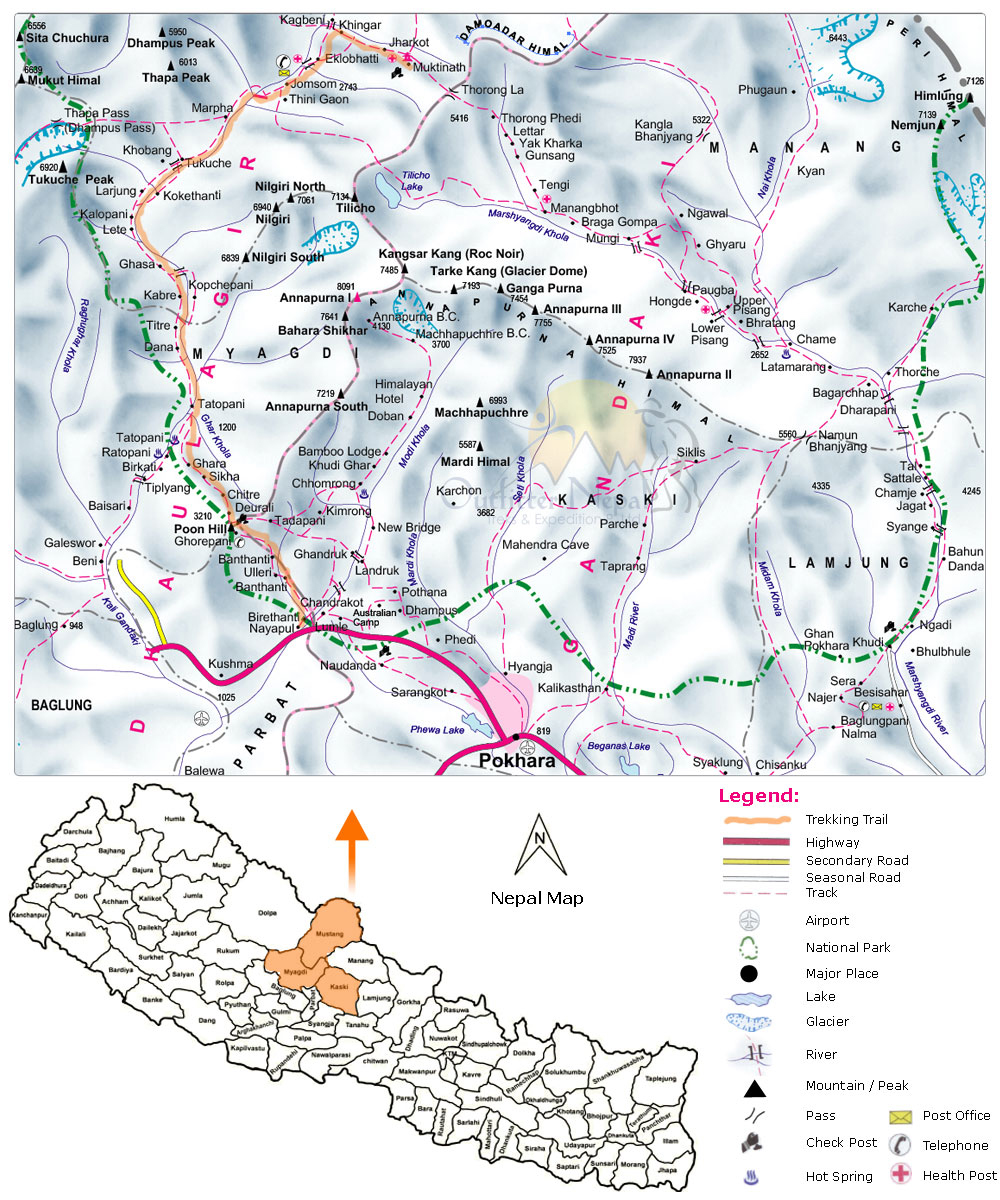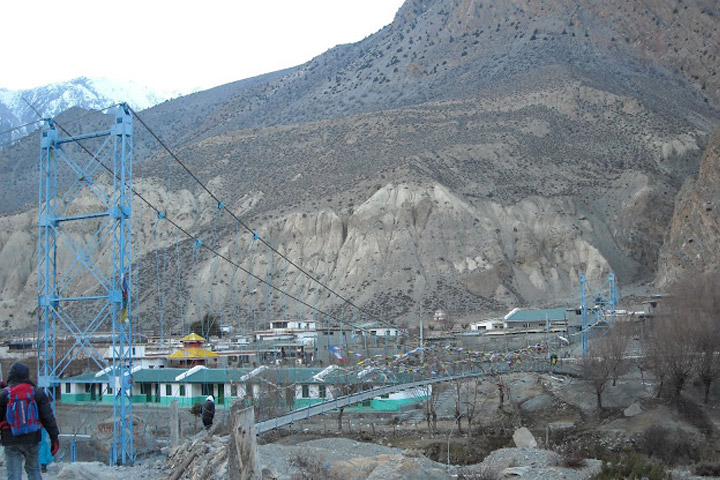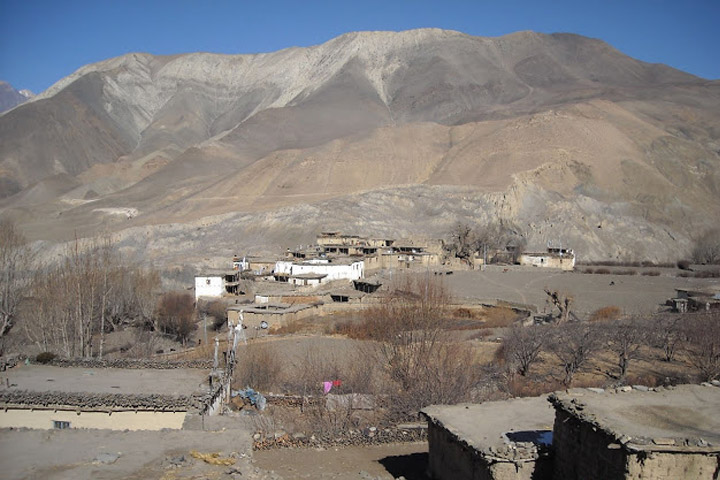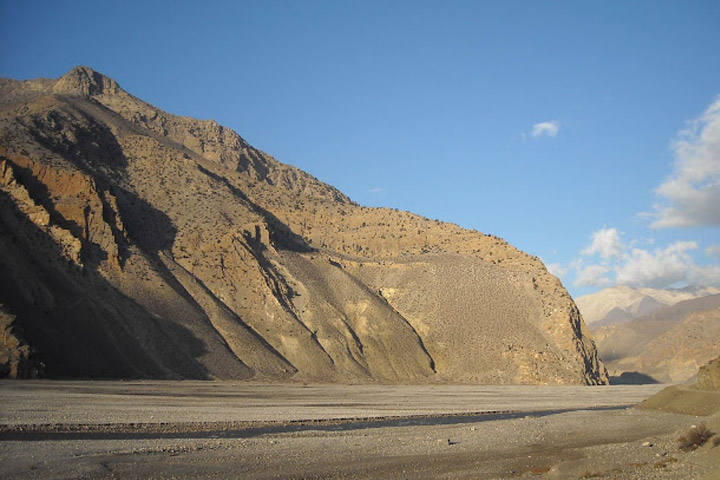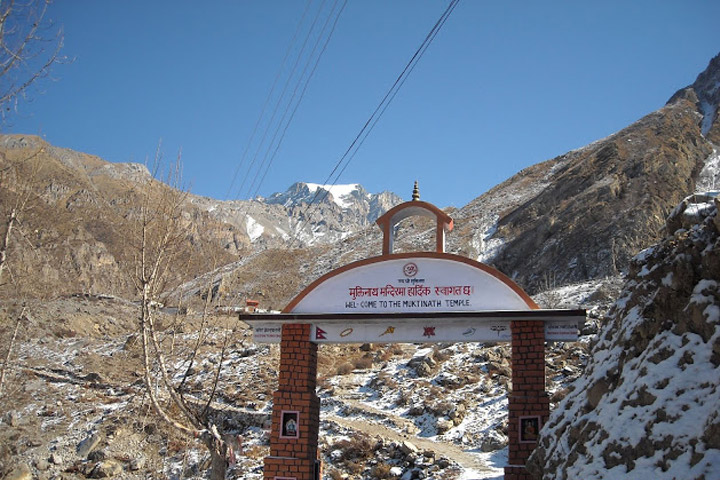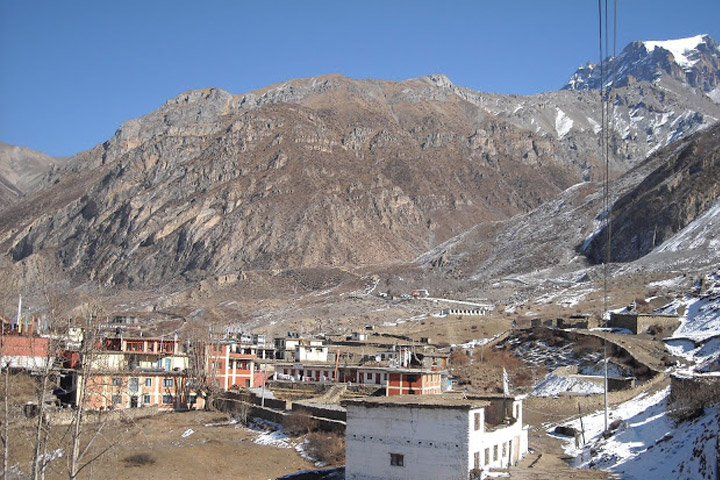Jomsom Muktinath Trekking is situated North of Pokhara, Nepal’s spectacular diversity appears at its finest The deep valleys and high mountains encircling the giant Annapurna Himal embrace a wide range of peoples and terrain, from subtropical jungle to a high, dry landscape resembling the Tibetan Plateau. This is the most popular trekking region, attracting over 75% of all trekkers (more than 30.000 annually). It’s also among the tamest areas, with excellent lodges lining the main routes. Finding Nepal beneath the flood of trekkers can be difficult, but the scenery and culture are top-notch, and you can avoid the peak-season crush and still get fine weather and views.
The views of the mountains are spectacular, and the route actually crosses to the other side of the main Himalayan range for some unusual views of the northern flanks.
This Jomsom Muktinath Trekking is start from Pokhara and leads you through the valley of the Kali Gandaki River to the pilgrim site of Muktinath. The physical beauty along the Jomsom Muktinath trek is breathtaking. The mountain viewing is brilliant in this trek and various ethnic groups of Nepal can be encountered along the way. The diverse landscapes and cultures to be found along this trekking route give a marvelous insight into the rural life of Nepalese people. The main feature of this trek is walking through the gorge carved by the Kali Gandaki River. This River forms the largest gorge in the world, on one side lies the Annapurna mountain range and on the other side is Dhaulagiri. The final destination of the Trek is to reach the Muiktinath (3800m).
Muktinath is of religious importance for both Hindus and Buddhists. The main shrine is a pagoda shaped temple dedicated to lord Vishnu; there are 108 water spouts around the wall of temple. The Jwala mai temple near by contains a spring and an eternal flame fed by natural gas underground. Since ancient times, there divine flames of jwala have been worshipped as Jwaladevi(the goddes of flame.
Day 01- Arrival in Kathmandu airport (1345meters).
There you will be met by our Airport Representative and transferred to hotel by private tourist vehicle. Overnight at your hotel with breakfast included.
Day 02- Pre-trip Meeting and Sightseeing around Kathmandu valley.
In the morning after breakfast at 9 AM, we host a Pre-Trip meeting at your hotel in Kathmandu and introduced your trek Leader/Guide mean time and it will provide an opportunity for individuals to ask questions about the your trek and to introduce you to other participants. This includes a final briefing and preparations for the trip.
PLEASE ADVISE US IF YOU WILL BE ARRIVING LATE AND ARE THEREFORE UNABLE TO ATTEND THE PRE-TRIP MEETING.
In THE PRE-TRIP MEETING All passengers MUST bring:
1. Passport.
2. Four copies of Passport size photos each.
3. Travel Insurance Policy.
4. A writing pen
5. Notepad.
After the Pre-Trip meeting and breakfast your sightseeing trip will start at 9.45 AM in the morning. We provide a private vehicle and professional tour guide. We visit Bodhnath Stupa, one of the biggest Buddhist shrines in the world, where we observe Buddhist monks in prayer in the monasteries surrounding the stupa. After Bodhnath Stupa we visit Pashupatinath, the most famous Hindu temple in the country, located on the banks of the holy Bagmati River. Here we see Hindu holy men (sadhus) meditating, pilgrims bathing and occasionally funeral pyres burning on the ghats. We also visit Bhaktapur Durbar Square, which is a collection of pagoda and shikhara – style temples grouped around a fifty-five-window palace of brick and wood. The attraction of the Bhaktapur Durbar Square is The Lion gate, The Golden gate, The Palace of fifty five windows, Art Galleries, The Statue of King Bhupatindra Malla.
The rest of our time in Kathmandu is free for further exploration and some last-minute shopping in Thamel area near by your hotel. Later, we are supplied with our Trek Pack and departure information for tomorrow. Overnight at hotel.
Day 03- Drive to Pokhara (900 meters) 7 hours by tourist bus.
Trekking staff will come to your Hotel at 6.30am in the morning to pick you up, 7 hour driving journey to Pokhara. Overnight at hotel.
Day 04- Drive to Nayapul (1010meters) and trek to Tikhedunga (1570meters) 3 hours. We begin our trek at Nayapul after 1 hour driving by private vehicle from Pokhara. After 15 minutes a short walk along the banks of the Modi Khola, we reach Birethanti (1015meters) a large village that has many shops and teahouses. From there, the trail continues through the village. The trail follows the north bank of the Bhurungdi Khola. Then the trail climbs steadily up the side of the valley to Hille at 1495m and after the short climb, we reach Tikhedhunga at 1570meters. Today’s walk offers a short and relatively easy day, during the journey which allows us to become used to the experience of trekking in Nepal. Overnight at guesthouse.
Day 05- Trek to Ghorepani (2840meters) 5 hours.
Leaving Tikhedunga, we begin our journey with a steep climb to Ulleri. Ulleri is a large Magar village at 2070meters. The trail then continues to ascend more gently, through fine forests of oak and rhododendrons towards Banthanti at 2250meters. We trek towards Nangethanti at 2460m. After an hour of walk this brings you to Ghorepani at 2840meters. Overnight at guesthouse.
Day 06- Hike up to Poon Hill (3210meters) and trek to Tatopani (1190meters). 6 hours.
It’s an early morning rise at 5 o’clock; we begin trekking for Poon Hill. It takes an hour to climb from Ghorepani to Poon Hill, presenting you with one of the best Himalayan viewpoints in Nepal from where spectacular Himalayan ranges with amazing sunrise views can be seen very closely.
After observing the wonderful Himalaya views, we return to Ghorepani to have a hot breakfast. After breakfast, we continue our journey to Tatopani.
The trail makes a steep descent to Chitre at 2390m. As the trail drops down through Sikha, the hills are extensively terraced. Sikha is a large village with shops and hotels at 1980m, from there the trail descends gently to Ghara at 1705m. A further steep descent of 500m takes you to the Ghar Khola where the trail crosses the river on a suspension bridge. We then climb up above the Kaligandaki River before crossing too.
As you turn north, it takes you to the Tatopani at 1180m. Tato means ‘hot’ and pani is ‘water’, a name earned courtesy of the hot springs by the river. Tatopani is a popular short trekking spot just out of Pokhara. Overnight at guesthouse.
Day 07- Trek to Ghasa (2010 meters) 5 hours.
Today, the trail climbs up the Kali Gandaki gorge, considered to be the deepest in the world which is situated between the two 8000meters peaks of Annapurna and Dhaulagiri. The trail rises gently up to Dana at 1400meters, and onto Rupse Chhahara at 1550meters, there you can see a stunning waterfall. As the trail crosses to the eastern bank of the river, you will reach Kopchepani which crosses back to the western side on a suspension bridge at 1935meters. Then a short climb to Ghasa at 2010meters. Overnight at guesthouse.
Day 08- Trek to Tukche (2586m.) 5.30 hours.
We start the trek by crossing to the eastern side of the river, but cross back again further up the trail before entering Larjung at 2560meters. The trail continues on a short distance to the interesting village of Khobang with its narrow alleyways. Then we spend over night at the ancient Thakali village of Tukuche at 2590meters. Overnight at guesthouse.
Day 09- Trek to Kagbeni(2810m.) 5 hours.
From Tukche, we climb along the side of the valley to Jomsom at 2713meters. Jomsom is a large, bustling settlement and it’s the administrative centre to the region that contains the airport, army camp, hotels, shops, banks and government offices.
We cross the river to the eastern bank; then walk towards Eklai Bhatti at 2730meters. From here we take a direct route to Muktinath that ascends the hill behind the village, however we follow the trail along the river to Kagbeni at 2810meters which is situated at the junction of the Jhong Khola & the Kali Gandaki which is the northern most village that can be visited without a permit to continue on to Mustang. This village is fascinating with its rich Tibetan cultures and their unique hospitality which influences us greatly. Overnight at guesthouse.
Day 10- Trek to Muktinath (3802meters) 5 hours.
We make a steep climb up the Jhong Khola valley leaving Kagbeni, we then join the direct trail to Muktinath just below Khingar at 3200meters. From here trail continues high above the Jhong Khola to the imposing village of Jharkot at 3500meters, well worth exploring. We take a break here for lunch before continuing on to Muktinath.
As we leave Jharkot, the trail climbs up to our ultimate destination of Muktinath at 3802meters. We initially visit Ranipauwa, there are many teahouses and shops. Our overnight stay will be here. Further 10 minutes’ walks up the hill, we will be rewarded with the actual religious site of Muktinath & this area is kept free of hotels and camping sites. Muktinath is a pilgrimage center for Buddhists and Hindus. There we can see Tibetan traders as well as sadhus from the far south of India. There are shrines in a grove of trees including a Buddhists gompa & the Vishnu temple of Jwalamai. An old temple nearby shelters a spring and natural gas jets that provide Muktinath’s famous eternal flame. It’s the earth-water- fire combination that accounts for Muktinath’s great religious significance. Overnight at guesthouse.
Day 11- Trek back to Jomsom (2713meters) 5 hours.
Today we follow the same trail nearby Kagbeni and then the new trek takes you down to the Eklebhatti, then again follow same trail to Jomsom. Overnight at guesthouse.
Day 12- Morning flight to Pokhara.
Today 30 minutes morning flight takes us to Pokhara from Jomsom. Once we arrived at Pokhara airport, we then drive to hotel. In the afternoon we will have a sightseeing tour around Pokhara valley, which covers Fewa Lake, Devi’s water fall, Museum, Tibetan refugee settlement and Gupteshower cave etc. Overnight back at hotel.
Day 13- Leisure day and Sight in around Pokhara.
It’s also spare day in case of bad weather in Jomsom. Overnight at hotel.
Day 14- Drive back to Kathmandu (1345meters).
Overnight back at the hotel in Kathmandu by bus. If you are interested in continuing onto Chitwan Jungle Safari, River Rafting Adventure, Kathmandu Shopping Tour or Scenic Everest Flight. Overnight at hotel.
Day 15- Transfer to international airport for your final departure.
The trip ends, our Airport Representative will drop you to the Kathmandu international airport for your final flight departure from Nepal.
NOTE : The above information is a guide and standard template of what we provide. The trek can be customized at your request to accommodate your specific requirements.
NOTE: On adventure trips of this type, weather, local politics, transport or a multitude of other factors beyond our control can result in a change of itinerary. It is, however, very unlikely that the itinerary would be substantially altered; if alterations are necessary the leader will decide what is the best alternative, taking into consideration the best interests of the whole group. Where a change does occur, we do everything we can to minimize its effect, but we cannot be responsible for the results of changes or delays.
Q.What type of shape do I need to be in, is this trip for me?
A. Trekking is suitable for average people who are moderately fit, thus no previous experience is required. Some physical fitness programs such as running, swimming, hiking is recommended before you embark on your journey. Persons suffering from a pre-existing medical condition or disease must seek medical advice before considering the trek. Whilst on the trek, it is common to experience some discomfort before being fully acclimatized.
To prepare for a strenuous trek you should begin training at least two to three months before your departure. As a guideline, an hour of aerobic exercise three to four times per week would be considered a minimum requirement. The best preparation is bushwalking involving relatively steep ascents and descents. If you can manage a couple of valley floor to ridgeline ascents per comfortable and able to enjoy the trek to the fullest. They are physically strong, sharp-witted and have an incredibly positive attitude towards a life that we would consider extremely tough. There is something about a trek in the Himalaya that draws you back time and time again. For keen walkers it is a paradise and even avowed non-walkers find that one foot just seems to follow the other, drawn by the appeal of what lies beyond.
Q. Will somebody come to pick me up at the Airport upon my arrival?
A. Yes, our Airport Representative will be there to greet you outside of Terminal Hall, he/she will be displaying an Kiwi Adventures Treks & Expedition sign board. Upon arrival, you will be transferred to your hotel.
Q. What sort of accommodation can I expect in Kathmandu and in trekking?
A. 11 night’s Trekking Guesthouse, 4 nights three/four star hotels in Kathmandu.
We use standard rooms from three/four star hotels in Kathmandu with breakfast included. Along the trekking routes teahouses/Lodges generally provide basic clean facilities with a mattress and a quilt or blanket. We can also offer you sleeping bags if needed (which need to return after the trip) but it is a good idea to always have your own sleeping equipment. We usually provide single and double rooms as well as the occasional dormitory. The dining room is downstairs around a fire. All food will be cooked to order in the little kitchen. You should not enter the kitchen unless asked to do so.
Gypsum cardboard Children’s clothes Useful clauses
Toilet Facilities – On trek, common toilet facilities are available at Tea Houses.
Q. What sort of food can I expect in trekking?
A. In trekking most teahouses (lodges) cook a delicious range of mostly vegetarian fare. Pasta, tuna bakes, noodles, potatoes, eggs, dhal bhat, bread, soups, fresh vegetables (variety depends on the season) and even some desserts like apple pies, pancakes, and some interesting attempts at custard. You will find a lot of garlic on the menu because it assists with acclimatization – eat some every day. In many larger villages you may find some meat on the menu. You can always get hot chocolate, tea, and hot lemon drinks, as well as soft drinks, and treats like chocolate and crisps.
Each day dinner and breakfast are used to take in the same lodge you spend the night. Lunch will be taken on the way to destination.
Q. What sort of transportation you use?
A. Kiwi Adventures Treks & Expedition is all about providing you with local insights as well as adventure, with that in mind, where we think you will get more out of your holiday by using different means of transport that is what we do. Using a variety of private transport is an integral part of our Himalaya tours and enhances the experience!
We use private tourist vehicles for sightseeing, city tours and pickups. Depending on the group size we use cars, minibus, van or land cruiser. These small light vehicles are more manoeuvrable and flexible enabling us to take you through the Narrow roads of Nepal. All the vehicles are usually air-conditioned unless we are travelling in cooler areas.
Q. What is the best season for this trekking?
A. Our trekking season extends from mid- September to May. From early September the monsoonal rains decrease. By end of September through to December the weather is usually stable with mild to warm days, cold nights. February, March, April, May, October, November, December are the best time to do trek.
Q. What is the weather & temperature like in trekking?
A. Weather in the mountains is notoriously difficult to predict. At night it is generally cooler the days are generally warm. Winter (January and February) will be bit colder but the days can be quite beautiful and warm if the sun is out. There will be bit of snow during the month of January, February and December. It is also important to make sure that you can stay warm and dry in just about any conditions. Expect the unexpected! The temperature could be as high as 20 deg C to -15 deg C low.
Q. Can I charge my digital camera or other batteries on my trip?
A. These facilities will be available in most of the places in your hotel reception by paying some service charges. Remember to bring your adapters!
Q. Is there any communication while we are on trekking?
A. There are telephones in some villages along the trekking routes from which you can make international calls.
Q. Can I use credit cards in the places visit in trekking?
A. In most cities yes, to some extent, however once you leave those cities behind, all you need is cash.
Q. How much additional money do I need per day?
A. In Kathmandu, you can allocate US$ 10 – 25 for a lunch / dinner. It’s all depends on your spending habits. US$7 to 10 US$ a day will be enough to buy bottles of water, chocolates and few drinks in trekking.
Q. Do I need to tip my guide and porters? How much would that be?
A. This is a difficult thing to gauge. We have seen everything from 20USD to 1000 USD per person for guides and porters. Tipping is not required, but a small way to show your guides and local porters thanks for their help. The level of the tip should reflect the level of personal involvement with your guide.
Q. Is the water OK to drink? Do I need to bring purifying tablets/filter?
A. In most places bottled water is readily available. If you wish to drink normal water, you need to use purifying aid, which you will need to bring with you.
Q. Are the Kiwi Adventures Treks & Expedition staff insured?
A. Our company insures all our trekking staff, including guide, cook, sherpa and porters.
Q. What essential documents do I need to bring with me on tour?
A. *Valid Passport – must be valid for up to 6 months after you return from your tour, keep a separate photocopy.
*Travel insurance, keep a separate photocopy
*Cash and Traveller’s Cheques, keep numbers and proof of purchase separate
*Flight tickets
*Emergency contact numbers for T/C’s, banks, insurance, family contacts.
Q. Can I add extra days to my trekking trip?
A. A hoilday should never be about making it to the final point quickly. Along your trek we can add days at your request with additional costs to cover guides, porters, accommodation and food.
Q. Do you use yaks/porters on the trek or do we carry all of our own gear?
A. Whilst on the trek, our porter will take care of your luggage. All you need to carry is your small day bag for your personal belongings like camera, water bottle, sun cream etc only.
Q. What opportunities will I have for shower along the trek?
A. In major places, we arrange guesthouse with hot shower. And in rest of the places, hotel water in bucket will be provided for shower; it would cost you extra about USD 3-4 per shower.
Q. Do you know about how many total miles the trek is?
A. Total distance of the entire trek is about 75 miles.
Cost Includes
• Airport / Hotel / Airport pick up & drop by private car / van / bus.
• Standard twin sharing accommodation in four/five star hotel in Kathmandu breakfast included.
• Standard twin sharing accommodation in two/three star hotel in Pokhara breakfast included.
• Guided city tour in Kathmandu and Pokhara by private car / van / bus.
• All your standard Meals during the trek.
• Twin sharing Lodges, Guesthouses accommodation during the trek (15 nights Trekking Guesthouse) .
• Local k2 Summit Trek licensed English speaking Guide during the trek.
• The required number of local staff and Porters to carry your luggage during the trek.
• Food, accommodation, salary, insurance, equipment and medicine for all staff.
• Annapurna conservation Park permits.
• Surface transfer from and to Kathmandu.
• All our government taxes.
• Official expense.
Cost Excludes
• Lunch and dinner whilst in Kathmandu and Pokhara .
• Your travel insurance (compulsory, please contact us if you wish to sign up for the Global Rescue membership plan).
• International airfare and airport departure tax.
• Nepal entry visa, you can obtain a visa easily upon your arrival at Tribhuwan International Airport in Kathmandu. (Tourist Visa with Multiple Entry for 30 days can be obtained by paying US $ 40 or equivalent foreign currency. Similarly, Tourist Visa with Multiple Entry for 90 days can be obtained by paying US $ 100. You will also require 2 passport size photos.)
• Alcoholic, hot and cold drinks.
• Personal trekking Equipment.
• Tips for trekking staff. (Tipping is expected).
• Any others expenses which are not mentioned on Price Includes section.
